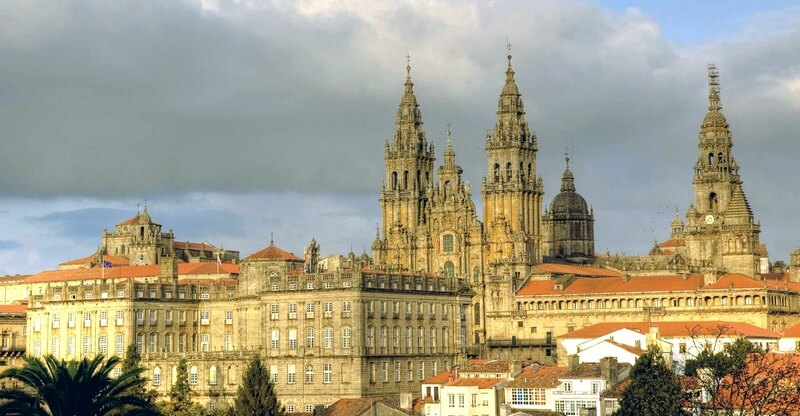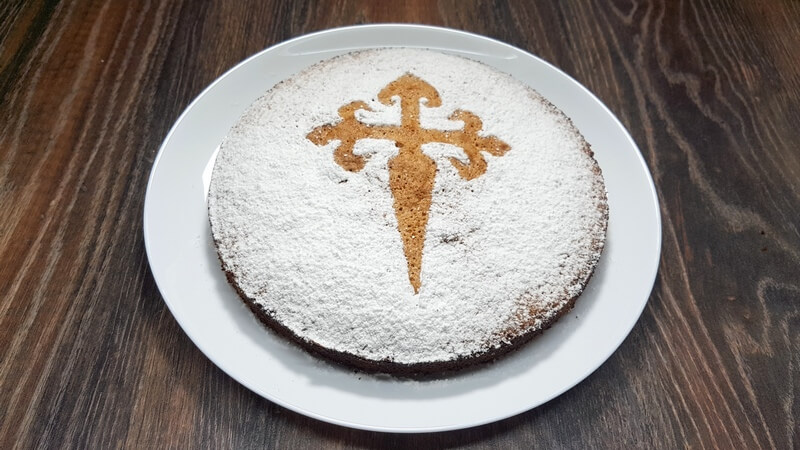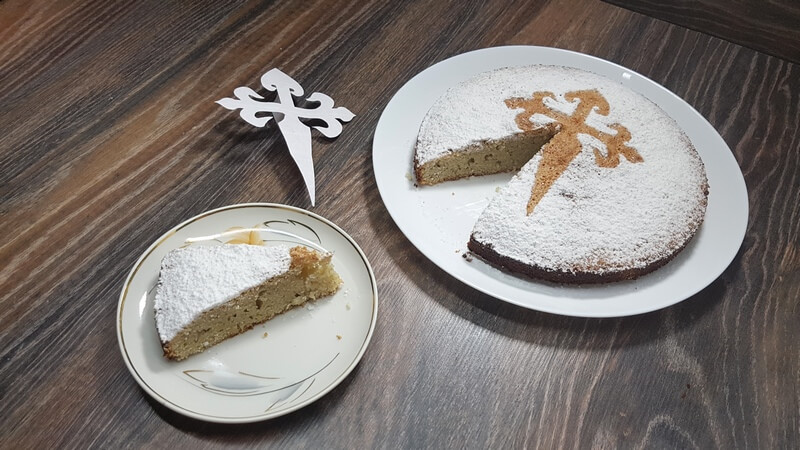 Almond Pie Tarta de Santiago is the most famous dessert of Galicia – the northwestern autonomous community of Spain. The unique taste and magical aroma of the cake fall in love with the first piece. You should definitely try this dessert, while in Galicia. After reading the article, you will learn about the history of the origin of the pie Tarta de Santiago and its distinctive features. Also here you will find a video recipe for almond dessert and understand, how easy it can be made at home.
Almond Pie Tarta de Santiago is the most famous dessert of Galicia – the northwestern autonomous community of Spain. The unique taste and magical aroma of the cake fall in love with the first piece. You should definitely try this dessert, while in Galicia. After reading the article, you will learn about the history of the origin of the pie Tarta de Santiago and its distinctive features. Also here you will find a video recipe for almond dessert and understand, how easy it can be made at home.
Although the cuisine of Galicia is famous for seafood, fish and beef, sweets also occupy an important place in it. Galician housewives often cook pancakes with cream, brushwood (Orejas) and sweet pies (Larpeira, Bica) to their households. But every year on July 25, in each Galician house traditionally bakes almond pie Tarta de Santiago. Want to know why?
The thing is, that this day they remember the Holy Apostle Santiago (St. James, Jacob), who is the patron saint of Spain. According to Christian tradition, after the death of the holy Apostle in the year 44, his relics in the ark were put into a boat and allowed her to sail in the Mediterranean. The boat stuck to the Spanish coast at the mouth of the river Ulya. In the 9th century (813), the ark was discovered by the monk Pelayo. The relics after so many centuries remained imperishable. At the end of the 9th century, on the orders of King Alfonso III, a small chapel was built above the ark. This place was named Compostela in honor of the star, which showed the monk the way to the relics. Later, the city was renamed Santiago de Compostela.

Saint James (Santiago) – the patron and protector of Spain
In the Middle Ages, St. James appeared in visions to the Knights of the Reconquista (recapturing the lands of the Iberian Peninsula from the Moors) and helped them in their struggle against the Moors. For this he was nicknamed Matаmoros and began to be considered the patron saint of Spain. Now on the site of the old chapel and several temples, that have replaced it, is the largest in the world Santiago Cathedral. Thousands of pilgrims come here every year, who walk along the “Way of Saint James” to the place, where the relics of the apostle of Christ rest. July 25th is the date of the death of Santiago, to whom all the Catholics of Spain give praise on this day.

Cathedral in the city of Santiago de Compostela
In 1160 in Spain, the Catholic Military Order of Santiago was established, which still exists today, but is now a civilian knightly order. The purpose of the Order was to protect and escort pilgrims, going to Santiago de Compostela from other parts of the country and Europe. The Knights also participated in the Reconquista and the Crusades. The symbol of the Order of St. James became an unusual cross-blade of red color, symbolizing the shedding of blood for the Christian faith, the willingness to die for it.
Galicia residentes invented a pie in the city of Santiago de Compostela in the Middle Ages and named it in honor of the patron saint of Spain Santiago (Tarta de Santiago). The dessert recipe was first discovered in 1838 in the records of Luis Bartolomeo de Liber. In 1924 in the Casa Mora confectionery shop did not just sprinkled the top of the cake with icing sugar, as it was before, but used for it a stencil depicting the cross-sword of the Order of St. James. The religious symbol was so liked by the residents and guests of the city, that since then everyone began to use it, when decorating the surface of Tarta de Santiago. Special stencils in the shape of a cross appeared in the stores, and each Galician homewives hurried to purchase them. Today such a stencil can be downloaded from the link and printed out on a printer.

Here is what the Galician almond cake of Santiago looks like (Tarta de Santiago)
So, lets go to the recipe of almond cake. The main ingredient of the dessert is almonds, crushed in flour. In Spain, which is the European leader in the sale of this product, it is costs cheaper, than in other countries. By the way, although almonds are called nuts, in fact it is a relative of plums, and we eat edible kernels of fruit.
For the preparation of dessert, they use either ready-made almond flour, or (more often) buy fruit kernels, and then grind them at home. Nuts should be peeled. To do this, they are poured with boiling water and left for 10 minutes, the water is drained, the kernels are poured again, but with cold water. After 15 minutes, the husks easily lag behind the almonds.
Peeled kernels are dried in a pan, so that the almonds reveal their unique aroma and taste, and then grind them in coffee grinders, blenders or food processors.
Medieval recipe for almond cake contained 3 ingredients: almonds, sugar and eggs. Currently, lemon zest and cinnamon are added to the cake. Sometimes butter is put into the dough. The ratio of products in the classic Tarta de Santiago should be as follows: 30% almonds, 30% sugar, 25% eggs, 15% icing sugar and other flavored additives.
We bring to your attention a video recipe for Santiago almond cake, provided to the site by Recipes International channel (english subtiles).
The recipe is simple, and you can quickly make a cake:
- Peel one lemon with a fine grater.
2. Eggs are combined with sugar until smooth (no need to whisk).
3. In the egg-sugar mixture is injected cinnamon, zest and chopped almonds, mix.
4. The dough is poured into a mold, greased with butter (the bottom should be covered with baking paper).
5. The cake is sent to bake in the oven, preheated at 180 ° C. Cooking time 30-40 minutes. Readiness is checked with a wooden stick. It should come out of the test is not wet, but dry.
6. After baking, the cake is cooled in the form, because due to its high nut content, it is quite fragile.
7. On the cooled dessert put the stencil of the cross of Santiago and sprinkle the surface of the cake with powdered sugar, then carefully remove the stencil. For convenience, we recommend gluing a handle to a paper or cardboard blank of the cross, then it is easier to remove it from the surface of the dessert without fear of spoiling the design with powder.
Do not be upset, that your cake turned out low, flat. He should not rise much. The main thing of pie – it should not raw and not burnt.

Galician almond pie cut with a stencil of the cross of St. James
In 2006, the Spaniards took the dessert trademark under protection. It is believed, that this pie can be called Santiago only if it was cooked in Spain. Therefore, outside the country, sweetness is more often called Galician almond cake.
Now you have the opportunity to cook a medieval dessert at home and enjoy its amazing taste. Maybe this cake will cause you an overwhelming desire to walk the Path of St. James to the city of Santiago de Compostela, to venerate the relics of the Spanish intercessor in the magnificent Romanesque cathedral of the 11th century built and taste the original dessert in a cozy pastry shop. And someone just wants to visit Galicia, one of the greenest corners of Spain, on both sides surrounded by the Atlantic Ocean and nicknamed long ago the “edge of the world.”

3 pings